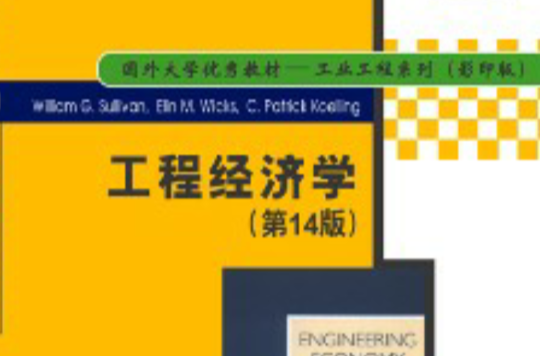Engineering Economy,14th Ed.(工程經濟學第14版)是清華大學出版社出版的一本圖書,作者是Sullivan/Wicks/Koelling。
基本介紹
- 書名:工程經濟學第14版
- 作者:Sullivan/Wicks/Koelling
- 原版名稱:Engineering Economy,14th Ed.
- ISBN:9787302246961
- 定價:70元
- 出版社:清華大學出版社
- 出版時間:2011-2-1
內容簡介,前言,目錄,
內容簡介
Willian G. Sullivan等編著的《工程經濟學(第14版)(影印版)》是工程經濟學領域的暢銷教材,麻省理工學院等數十所美國大學以及英國、韓國、新加坡等很多國家的一些知名院校都將本書作為“工程經濟學”課程的最主要教材。
本書系統介紹了工程經濟分析的理論、原理、方法和套用案例。全書共分為3部分。第1部分是工程經濟基本原理,主要闡述工程經濟分析的基本原則、重要的成本概念和估計技術、貨幣時間價值原理等?程經濟學的基本概念和原理;第2部分介紹工程經濟基本方法,深入分析了投資方案的贏利性評價方法和比選方法,折舊、所得稅、通貨膨脹等對評價方法的影響,設備更新分析方法,不確定性分析方法;第3部分為工程經濟分析方法特別專題,內容包括公共項目的費用效益分析方法、風險分析技術和融資及資本預算方法。
《工程經濟學(第14版)(影印版)》適合作為經濟類、管理類、工業工程及相關專業本科生或研究生的教材。
前言
本教材系列的出版正值中國學術界工業工程學科經歷巨大發展,實際工作中對工業工程的概念、方法和工具的使用興趣日漸濃厚之時。在實際工作中有效地套用工業工程的手段將無疑會提高生產率、工作質量、合作的滿意度和效果。
該系列中的書籍對工業工程的本科生、研究生和工業界中需要解決工程系統設計、運作和管理諸方面問題的人士最為適用。
加弗瑞爾·沙爾文迪
清華大學工業工程系
普渡大學工業工程學院(美國)
2002年4月
目錄
目錄
Preface
Acknowledgments
PART 1 Fundamentals of Engineering Economy
CHAPTER 1 Introduction to Engineering Economy
1.1 Introduction
1.2 The Principles of Engineering Economy
1.3 Engineering Economy and the Design Process
1.4 Using Spreadsheets in Engineering Economic Analysis
1.5 Summary
CHAPTER 2 Cost Concepts and Design Economics
2.1 Cost Terminology
2.2 The General Economic Environment
2.3 Cost-Driven Design Optimization
2.4 Present Economy Studies
2.5 Case Study——The Economics of Daytime Running Lights
2.6 Summary
Appendix 2-A Accounting Fundamentals
CHAPTER 3 Cost-Estimation Techniques
3.1 Introduction
3.2 An Integrated Approach
3.3 Selected Estimating Techniques (Models)
3.4 Parametric Cost Estimating
3.5 Cost Estimation in the Design Process
3.6 Case Study——Demanufacturing of Computers
3.7 Summary
CHAPTER 4 The Time Value of Money
4.1 Introduction
4.2 Simple Interest
4.3 Compound Interest
4.4 The Concept of Equivalence
4.5 Notation and Cash-Flow Diagrams and Tables
4.6 Relating Present and Future Equivalent Values of Single Cash Flows
4.7 Relating a Uniform Series (Annuity) to Its Present and Future Equivalent Values
4.8 Summary of Interest Formulas and Relationships for Discrete Compounding
4.9 Deferred Annuities (Uniform Series)
4.10 Equivalence Calculations Involving Multiple Interest Formulas
4.11 Uniform (Arithmetic) Gradient of Cash Flows
4.12 Geometric Sequences of Cash Flows
4.13 Interest Rates that Vary with Time
4.14 Nominal and Effective Interest Rates
4.15 Compounding More Often than Once per Year
4.16 Interest Formulas for Continuous Compounding and Discrete Cash Flows
4.17 Case Study——Understanding Economic “Equivalence”
4.18 Summary
Part Ⅱ Engineering Economy in Action
CHAPTER 5 Evaluating a Single Project
5.1 Introduction
5.2 Determining the Minimum Attractive Rate of Return (MARR)
5.3 The Present Worth Method
5.4 The Future Worth Method
5.5 The Annual Worth Method
5.6 The Internal Rate of Return Method
5.7 The External Rate of Return Method
5.8 The Payback (Payout) Period Method
5.9 Case Study——A Proposed Capital Investment to Improve Process Yield
5.10 Summary
Appendix 5-A The Multiple Rate of Return Problem with the IRR Method
CHAPTER 6 Comparison and Selection among Alternatives
6.1 Introduction
6.2 Basic Concepts for Comparing Alternatives
6.3 The Study (Analysis) Period
6.4 Useful Lives Are Equal to the Study P.eriod
6.5 Useful Lives Are Unequal among the Alternatives
6.6 Personal Finances
6.7 Case Study--Ned and Larry's Ice Cream Company
6.8 Postevaluatio.n of Results
6.9 Summary
CHAPTER 7 Depreciation and Income Taxes
7.1 Introduction
7.2 Depreciation Concepts and Terminology
7.3 The Classical (Historical) Depreciation, Methods
7.4 The Modified Accelerated Cost Recovery' System
7.5 A Comprehensive Depreciation Example
7.6 Introduction to ,Income Taxes
7,7 The Effective (Marginal)Corporate Income Tax Rate
7.8 Gain (Loss) on the Disposal of an Asset
7.9 General.Procedure for Making After;Tax Economic Analyses
7.10 Illustration of Computations of ATCFs
7.11 Economic Value Added
7.12 Summary
CHAPTER 8 Price Chancles and Exchancle Rates
8.1 Introduction
8.2 Terminology and Basic Concepts
8.3 Fixed and Responsive Annuities
8.4 Spreadsheet Application
8.5 Foreign Exchange Rates and Purchasing Power Concepts
8.6 Case Study--Selecting Electric to Power an Assembly Line
8.7 Summary
CHAPTER 9 Replacement Analysis
9.1 Introduction
9.2 Reasons for Replacement Anaiysis
9.3 Factors that Must Be Considered in Replacement Studies
9.4 Typisal Replacement Problems
9.5 Determining the Economic Life:of a New Asset (Challenger)
9.6 Determining the Economic Life of a Defender
9.7 Comparisons in which the Defender's Useful Life Differs from that of the Challenger
9.8 Retirement without Replacement (Abandonment)
9.9 AfterTax Replacement Studies
9.10 Case Study--Replacement of a Hospital's Emergency Electrical Supply System
9.11 Summary
PART Ⅲ Additional Topics in Engineering Economy
CHAPTER 10 Evaluating Projects with the Benefit-Cost Ratio Method
10.1 Introduction
10.2 Perspective and Terminology for Analyzing Public Projects
10.3 Self-Liquidating Projects
10.4 Multiple-Purpose Projects
10.5 Difficulties in Evaluating Public-Sector Projects
10.6 What Interest Rate Should Be Used for Public Projects?
10.7 The Benefit-Cost Ratio Method
10.8 Evaluating Independent Projects by B-C Ratios
10.9 Comparison of Mutually Exclusive Projects by B--C Rations
10.10 Criticisms and Shortcomings of the Benefit-Cost Ratio Method
10.11 Case Study--Improving a Railroad Crossing
10.12 Summary
CHAPTER 11 Breakeven and Sensitivity Analysis
11.1 Introduction.
11.2 Breakeven Analysis
11.3 Sensitivity Analysis
11.4 Multiple Factor Sensitivity Analysis
11.5 Case Study--Analysis of a Business Venture
11.6 Summary
CHAPTER 12 Probabilistic Risk Analysis
12.1 Introduction
12.2 Sources of Uncertainty
12.3 The Distribution of Random Variables
12.4 Evaluation of Projects with Discrete Random Variables
12.5 Evaluation of Projects with Continuous Random Variables
12.6 Evaluation of Uncertainty by Monte Carlo Simulation
12.7 Performing Monte Carlo Simulation with a Computer
12.8 Decision Trees
12.9 Real Options Analysis
12.10 Case Study--The Oils Well That Ends Well Company
12.11 Summary
CHAPTER 13 The Capital Budgeting Process
13.1 Introduction
13.2 Debt Capital
13.3 Equity Capital
13.4 The Weighted Average Cost of Capital (WACC)
13.5 Project Selection
13.6 Postmortem Review
13.7 Budgeting of Capital Investments and Management Perspective
13.8 Leasing Decisions
13.9 Capital Allocation
13.10 Case Study--Financing an Automobile
13.11 Summary
CHAPTER 14 Decision Making Considering Multiattributes
14.1 Introduction
14.2 Examples of Multiattribute Decisions
14.3 Choice of Attributes
14.4 Selection of a Measurement Scale
14.5 Dimensionality of the Problem
14.6 Noncompensatory Models
14.7 Compensatory Models
14.8 Summary
PART Ⅳ Appendices
A Using Excel to Solve Engineering Economy Problems
B Abbreviations and Notation
C Interest and Annuity Tables for Discrete Compounding
D Interest and Annuity Tables for Continuous Compounding
E Standard Normal Distribution
F Selected References
G Answers to Selected Problems
Index

